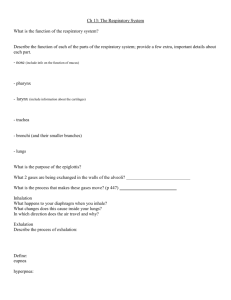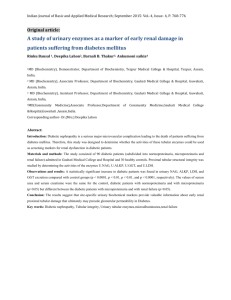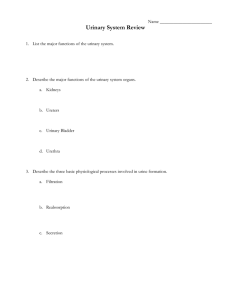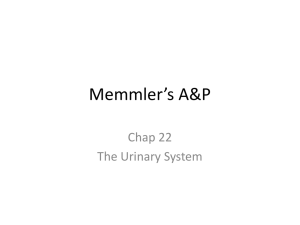Asian Journal of Medical Sciences 3(3): 84-90, 2011 ISSN: 2040-8773
advertisement
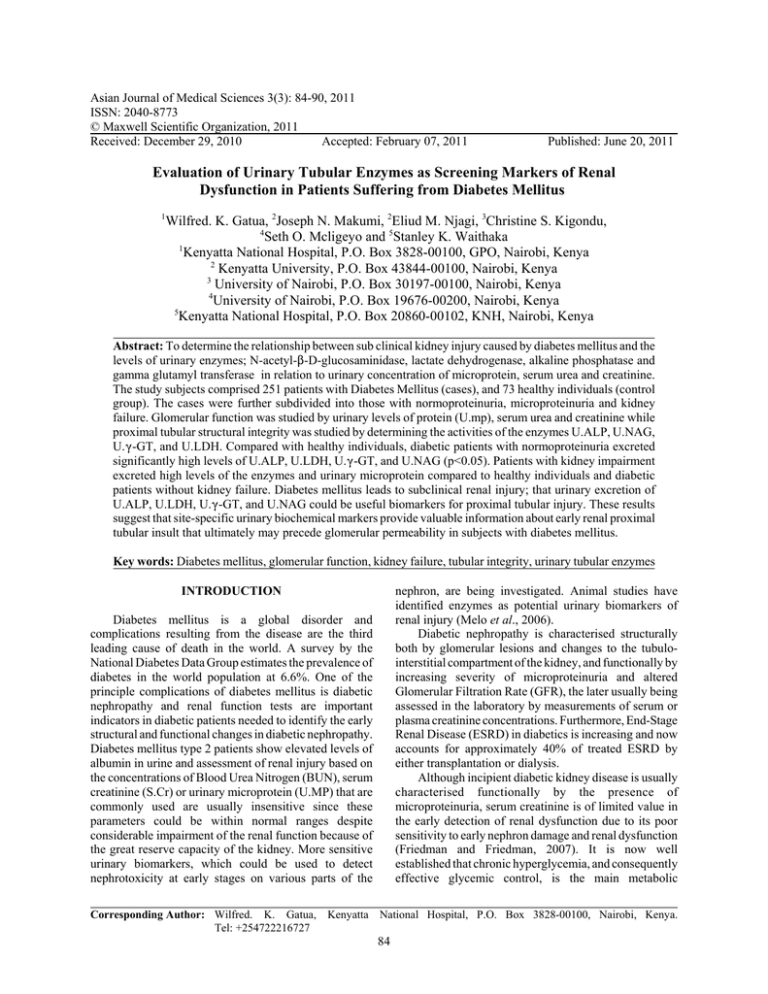
Asian Journal of Medical Sciences 3(3): 84-90, 2011 ISSN: 2040-8773 © Maxwell Scientific Organization, 2011 Received: December 29, 2010 Accepted: February 07, 2011 Published: June 20, 2011 Evaluation of Urinary Tubular Enzymes as Screening Markers of Renal Dysfunction in Patients Suffering from Diabetes Mellitus 1 Wilfred. K. Gatua, 2Joseph N. Makumi, 2Eliud M. Njagi, 3Christine S. Kigondu, 4 Seth O. Mcligeyo and 5Stanley K. Waithaka 1 Kenyatta National Hospital, P.O. Box 3828-00100, GPO, Nairobi, Kenya 2 Kenyatta University, P.O. Box 43844-00100, Nairobi, Kenya 3 University of Nairobi, P.O. Box 30197-00100, Nairobi, Kenya 4 University of Nairobi, P.O. Box 19676-00200, Nairobi, Kenya 5 Kenyatta National Hospital, P.O. Box 20860-00102, KNH, Nairobi, Kenya Abstract: To determine the relationship between sub clinical kidney injury caused by diabetes mellitus and the levels of urinary enzymes; N-acetyl-$-D-glucosaminidase, lactate dehydrogenase, alkaline phosphatase and gamma glutamyl transferase in relation to urinary concentration of microprotein, serum urea and creatinine. The study subjects comprised 251 patients with Diabetes Mellitus (cases), and 73 healthy individuals (control group). The cases were further subdivided into those with normoproteinuria, microproteinuria and kidney failure. Glomerular function was studied by urinary levels of protein (U.mp), serum urea and creatinine while proximal tubular structural integrity was studied by determining the activities of the enzymes U.ALP, U.NAG, U.(-GT, and U.LDH. Compared with healthy individuals, diabetic patients with normoproteinuria excreted significantly high levels of U.ALP, U.LDH, U.(-GT, and U.NAG (p<0.05). Patients with kidney impairment excreted high levels of the enzymes and urinary microprotein compared to healthy individuals and diabetic patients without kidney failure. Diabetes mellitus leads to subclinical renal injury; that urinary excretion of U.ALP, U.LDH, U.(-GT, and U.NAG could be useful biomarkers for proximal tubular injury. These results suggest that site-specific urinary biochemical markers provide valuable information about early renal proximal tubular insult that ultimately may precede glomerular permeability in subjects with diabetes mellitus. Key words: Diabetes mellitus, glomerular function, kidney failure, tubular integrity, urinary tubular enzymes INTRODUCTION nephron, are being investigated. Animal studies have identified enzymes as potential urinary biomarkers of renal injury (Melo et al., 2006). Diabetic nephropathy is characterised structurally both by glomerular lesions and changes to the tubulointerstitial compartment of the kidney, and functionally by increasing severity of microproteinuria and altered Glomerular Filtration Rate (GFR), the later usually being assessed in the laboratory by measurements of serum or plasma creatinine concentrations. Furthermore, End-Stage Renal Disease (ESRD) in diabetics is increasing and now accounts for approximately 40% of treated ESRD by either transplantation or dialysis. Although incipient diabetic kidney disease is usually characterised functionally by the presence of microproteinuria, serum creatinine is of limited value in the early detection of renal dysfunction due to its poor sensitivity to early nephron damage and renal dysfunction (Friedman and Friedman, 2007). It is now well established that chronic hyperglycemia, and consequently effective glycemic control, is the main metabolic Diabetes mellitus is a global disorder and complications resulting from the disease are the third leading cause of death in the world. A survey by the National Diabetes Data Group estimates the prevalence of diabetes in the world population at 6.6%. One of the principle complications of diabetes mellitus is diabetic nephropathy and renal function tests are important indicators in diabetic patients needed to identify the early structural and functional changes in diabetic nephropathy. Diabetes mellitus type 2 patients show elevated levels of albumin in urine and assessment of renal injury based on the concentrations of Blood Urea Nitrogen (BUN), serum creatinine (S.Cr) or urinary microprotein (U.MP) that are commonly used are usually insensitive since these parameters could be within normal ranges despite considerable impairment of the renal function because of the great reserve capacity of the kidney. More sensitive urinary biomarkers, which could be used to detect nephrotoxicity at early stages on various parts of the Corresponding Author: Wilfred. K. Gatua, Kenyatta National Hospital, P.O. Box 3828-00100, Nairobi, Kenya. Tel: +254722216727 84 Asian J. Med. Sci., 3(3): 84-90, 2011 determinant associated with irreversible kidney damage in diabetes mellitus type 2. Although microproteinuria has been used for many years as a predictor of incipient diabetic nephropathy, reflecting the loss of glomerular selectivity, estimation of renal tubular function and integrity may provide an early indication of renal dysfunction and thus identify those at risk of developing kidney failure. It has been shown that early renal tubular damage is characterised by increased proximal tubular enzymuria (Jung et al., 1993). Most cytosol and brush-border enzymes leak from the cells as a result of increased tissue damage. These enzymes are normally degraded through the normal metabolism but most of them are excreted from the body unchanged through the kidney. Increased excretion of urinary enzymes is often used to detect nephrotoxicity and renal disease. Such measurements of enzyme activity in urine provide a sensitive assessment for renal tubular cell damage, thereby enabling detection of sub-clinical tubular injury (Jung et al., 1993). Renal dysfunction in general and glomerular dysfunction in particular are observed only rarely in early diabetic nephropathy, and the identification of early renal damage and those at risk of developing renal dysfunction is important so that corrective therapies can be applied at an early stage. The aim of this study was therefore to investigate the association between the urinary enzyme activities of Nacetyl-b-d-glucosaminidase (NAG), Lactate Dehydrogenase (LDH), Alkaline Phosphatase (ALP), and Gamma Glutamyl Transferase ((-GT) in subjects with type 2 diabetes and the severity of microproteinuria. This study aimed to investigate whether urinary activities of NAG, ALP, LDH and (-GT can be used as renal dysfunction screening markers in patients suffering from diabetes mellitus type 2. Against the above background, this study investigated the effects diabetes mellitus type 2 on the kidney by measuring urinary excretion levels of NAG, (-GT, ALP, LDH and other proteins among patients suffering from diabetes mellitus type 2. normally held on Fridays where patients are seen by doctors and other health personnel. About 100 patients are normally seen every Friday. Over 90% of these patients suffer from diabetes mellitus type 2 and most of them are either on oral hypoglycaemic drugs or insulin or both. In order to monitor the status of the kidney, doctors usually request for urinary microprotein, serum urea and creatinine. Recruitment criteria: All the individuals were asked to participate in the study on a voluntary basis after a brief explanation of the aims and purpose of the study. Those who accepted to participate were subjected to an interview using a questionnaire. All those patients suffering from diabetes mellitus type 2 above the age of 18 years and normal healthy individuals within the same age group were included in the study. All those subjects with renal failure, kidney transplant, urinary tract infections, smoking habits, history of alcohol intake and those on antibiotics were excluded from the study. For the referent group, in addition to the above criteria, the study subjects were excluded from the study if they had regularly consumed drugs with potential nephrotoxicity (such as analgesics/anti-inflammatory agents, and aminoglycosides). They were also excluded from the study if they tested positive for HIV, hepatitis B, hepatitis C and syphilis. Urinalysis was done on the urine samples provided to screen for various medical conditions that could consequently affect the excretion of urinary parameters. The parameters checked in the urinalysisincluded glucose, proteins, leucocytes, blood, nitrates, Bilirubin, Urobilinogen, pH, S.G., and ketones. Those with positive results were excluded from the study. Eligible subjects were then requested to sign a consent form provided. Sample collection: After application of the mentioned criteria, only 372 study subjects were selected to participate in the present. They were grouped as follows: C MATERIALS AND METHODS Study area/study population: The study was carried out in Kenya between the months January to October 2009. The study subjects were recruited from the Kenyatta National Hospital Medical Out-Patient Clinic, while the control population were derived from Kenyatta National Hospital workers and healthy blood donors. Kenyatta National Hospital is teaching, research and referral hospital with an inpatient bed capacity of 2500. Diabetic clinic is an out- patient clinic in Kenyatta National Hospital that deals with both new and known diabetic patients. All diabetic cases are monitored, investigated and managed from this particular clinic. The clinic is C C 85 Non-diabetic control group (referent), consisting of 88 subjects (52 males and 36 females) working in the clinical areas of Kenyatta National Hospital. Age range was 21-65 years, with 41.11±12.15 years as mean Normoproteinuric diabetic patients consisting of 159 subjects (73 males and 86 females) attending outpatient diabetic clinic at Kenyatta National Hospital. Age range was 24-80 years, with a mean of 49.97±13.28 years Microproteinuric diabetic patients consisting of 43 subjects (25 males and 18 females) attending outpatient diabetic clinic at Kenyatta National Hospital. Age range was 22-77 years, with a mean of 56.29±15.32 years Asian J. Med. Sci., 3(3): 84-90, 2011 C Table 1: The established control ranges for urinary and serum renal markers in the control group Analyte Sex N Mean±SD Control range p-value U.NAG M 43 15.54±3.32 9.03-22.04 0.741 (U/mmolcr) F 30 15.29±3.07 9.27-21.31 M/F 73 15.44±3.20 9.17-21.71 U.ALP M 43 0.55±0.24 0.08-1.02 0.481 (U/mmolcr) F 30 0.51±0.25 0.02-1.00 M/F 73 0.53±0.24 0.06-1.00 U.LDH M 43 0.85±0.19 0.48-1.22 0.176 (U/mmolcr) F 30 0.92±0.20 0.53-1.31 M/F 73 0.88±0.20 0.48-1.27 M 43 2.69±0.47 1.77-3.61 0.196 U.(-GT (U/mmolcr) F 30 2.54±0.50 1.74-3.52 M/F 73 2.63±0.48 1.69-3.57 U.MP M 43 5.26±2.23 0.89-9.63 0.342 (mg/mmolcr) F 30 4.77±1.65 1.54-8.00 M/F 73 5.03±1.94 1.23-8.83 S.Urea M 43 4.3±1.4 1.60-7.04 0.742 (mmol/L) F 30 4.1±1.3 1.60-6.64 M/F 73 4.1±1.3 1.60-6.70 S.Creat M 43 92±15.0 62.6-121.4 0.001 F 30 78±15.4 47.8-108.2 (:mol/L) U.NAG- Urinary N-acetyl-$-D-glucosaminidase; U.ALP- Urinary Alkaline Phosphatase; U.LDH- Urinary Lactate Dehydrogenase; U.(GT- Urinary Gamma Glutamyl Transferase; U.MP- Urinary Microprotein; S.Urea- Serum Urea; S.creat- Serum Creatinine; U/mmolcr- Units per millimole of creatinine; mmol/l- Millimole per litre; mg/mmolcr- Milligrams per millimole of creatinine; µmol/lmicromole per litre; M- Male; F- female; N- Sample size; SD- Standard Deviation Renal diabetic patients consisting of 82 subjects (45 males and 37 females) attending renal out-patient clinic at Kenyatta National Hospital. Age range was 34-81 years, with a mean of 62.01±10.69 years A random single voided, morning urine sample in a closed container was collected from each participant. The urine was centrifuged at 3000 rpm for 5 min. The supernatant was distributed in vials of 1.5ml each and biochemical analysis was done within four hours. The remaining sample was kept frozen at -20oC. A sample of blood (about 5.0 mL) was also collected from each participant and put in a vacutainer. Sample analysis: The machines that were used for the samples analysis were the Olympus AU640 analyzer, (Japan, Mishima Olympus Optical Company Limited) for the enzymes, urea and creatinine and the Technicon Bayer RA 1000 (Ireland Technicon Limited) for urinary microprotein. Internal quality control: To ensure that the control ranges for the various methods were reliable and precise, internal Quality Control (QC) was included throughout the analytical period of the study. The control value results and the Standard Deviation (SD) from the target control value (central point value of the quality control range provided by QC supplier) were noted daily. glucosaminidase was 9.03-22.04 U/mmolcr for males and 9.27-21.31 U/mmolcr for females; lactate dehydrogenase was 0.48-1.22 U/mmolcr for males and 0.53-1.31 U/mmolcr for females; alkaline phosphatase was 0.08- 1.02 U/mmolcr for males and 0.02-1.00 U/mmolcr for females; gamma glutamyl transferase was 1.77-3.61 U/mmolcr for males and 1.74-3.52 U/mmolcr for females while for urinary micro protein it was 0.89-9.63 mg/mmolcr for males and 1.54-8.0 mg/mmolcr for females. The control ranges for urea were 1.60-7.04 mmol/L for males while for the females and 1.60-6.64 mmol/L. The male control ranges for serum creatinine was 63-121 :mol/L and that of females was 48-108:mol/L. Since no significant differences were observed in the values of the urinary enzymes, urinary micro protein, and serum urea between males and females, (p>0.05) these parameters were determined using combined data for both sexes. Results show a significant difference in the serum concentrations of creatinine between the males and the females (p<0.05) and therefore different control ranges for males and females were developed. Table 1 also shown the control values (combined males and females) for the urinary enzymes, urinary micro protein and serum urea and creatinine. The lower and upper limits of the control range for urinary N-acetyl$-D-glucosaminidase were 9.17 and 21.71 U/mmolcr, respectively; gamma glutamyl transferase were 1.69 and 3.57 U/mmolcr; urinary alkaline phosphatase 0.06 and Data management and analysis: Statistical analysis was done using SPSS program version11.0. Means differences between investigated groups (referents, normoproteinuric diabetic, microproteinuric diabetic and renal patients) were assessed by Anova and post Anova statistical analysis. Results were considered statistically significant at p<0.05 and all analyses were two-tailed. Ethical considerations: Consent was sort from the Kenyatta National Hospital Ethical and Research Committee (KNH-ERC) where the research was carried out. The participants were reassured of confidentiality in the handling of information and procedures involved in this study. Informed consent was sought from the participants and they were also requested to append their signature on the consent form in order to acknowledge their voluntary approval of participation. RESULTS Control ranges: Table 1 shows the mean values of the urinary enzymes N-acetyl-$-D-glucosaminidase, lactate dehydrogenase, alkaline phosphatase, gamma glutamyl transferase, urinary micro protein as well as serum urea and creatinine in normal healthy individuals (referent study group). The ranges for N-acetyl-$-D86 Asian J. Med. Sci., 3(3): 84-90, 2011 Table 2: Levels of urinary and serum biomarkers of renal injury in various stages of diabetic subjects/patients Healthy Normoproteinuric Microproteinuric Renal individuals diabetic group diabetic group individuals Parameter N = 73 N = 143 N = 34 N = 75 Mean (SD) Mean (SD) Mean (SD) Mean (SD) 33.00±6.41a,b 41.0±14.8a,b,c U.NAG (U/mmolcr) 15.44±3.20 20.01±3.54a U.ALP (U/mmolcr) 0.53±0.24 1.13±0.28a 1.99±0.39a,b 4.35±3.1 a,b,c U.LDH (U/mmolcr) 0.88±0.20 1.85±0.79 a 4.89±1.86 a,b 6.87±2.63 a,b,c U. (-GT (U/mmolcr) 2.63±0.48 4.39±0.98 a 6.05±1.74 a,b 13.1±6.7 a,b,c U.MP (mg/mmolcr) 5.03±1.95 5.40±2.10 29.1±10.1 a,b 48.2±27.6 a,b,c S.Urea (Mmol/l) 4.2±1.3 4.2±1.8 4.8±1.5 14.2±5.9a,b,c S.Creat (:mol/l) 86±16.4 86±18.9 92±16.3 214±96.1a,b,c Results are expressed as means±SD. Values with superscript a are different from the referents; values with superscript b are different from the normoproteinuric diabetes group; values with superscript c are different from the microproteinuric diabetic group; U.NAG- Urinary N-acetyl-$-Dglucosaminidase; U.ALP- Urinary Alkaline Phosphatase; U.LDH- Urinary Lactate Dehydrogenase; U.(-GT- Urinary Gamma Glutamyl Transferase; U.MP- Urinary Microprotein; S.Urea- Serum Urea; S.creat- Serum Creatinine; U/mmolcr- Units per millimole of creatinine; mmol/L- Millimole per litre; mg/mmolcr- Milligrams per millimole of creatinine; :mol/L- micromole per litre; N- Sample size; SD- Standard Deviation Table 3: Pearson correlation coefficient of urinary biomarkers in the various study groups Parameter Parameter Normoproteinuric subjects Microproteinuricsubjects Renal disease subjects r = 0.483** r = 0.708** r = 0.358* U.LDH U.(-GT U.NAG r = 0.643** r = 0.856** r = 0.747** U.ALP r = 0.436* r = 0.570** r = 0.534** U.MP N/C r = 0.412* r = 0.383** r = 0.447* r = 0.458* r = 0.591** U.ALP U.(-GT U.NAG r = 0.530** r = 0.538** r = 0.666** U.MP N/C r = 0.416* r = 0.535** U.NAG r = 0.617** r = 0.650* r = 0.624** U.(-GT U.MP N/C r = 0.566** r = 0.583** U.NAG U.MP N/C r = 0.475* r = 0.621** **: p-value < 0.001; *: p-value < 0.01; r = Pearson Correlation Coefficient; U.NAG: Urinary N-acetyl-$-D-glucosaminidase; U.ALP: Urinary Alkaline Phosphatase; U.LDH: Urinary Lactate Dehydrogenase; U.(-GT: Urinary Gamma Glutamyl Transferase; U.MP: Urinary Microprotein; N/C: No correlation the other hand, there were significant differences between values of the microproteinuric and the normoproteinuric groups as well as the renal and the microproteinuric groups (p<0.05). Levels of urinary lactate dehydrogenase indicated a progressive increase from the referent group through the renal group (p<0.05). The same trend was demonstrated by urinary gamma glutamyl transferase with the mean levels in the renal group being twice as high as that of the nephropathic, four times higher that of the nonnephropathic group and six times that of the referent group. The values of serum urea and serum creatinine were the same for the referent, non-nephropathic and nephropathic (p>0.05) but different between the nephropathic and the renal groups (p<0.05). The levels of N-acetyl-$-D-glucosaminidase, alkaline phosphatase, lactate dehydrogenase and gamma glutamyl transferase were about one and half times higher in normoproteinuric diabetic patients than in normal health individuals. In microproteinuric diabetic patients, the levels of N-acetyl$-D-glucosaminidase and gamma glutamyl transferase were twice higher than in normal health individuals while alkaline phosphatase, lactate dehydrogenase and microprotein they were about four times higher. 1.00 U/mmolcr and urinary lactate dehydrogenase 0.48 and 1.27 U/mmolcr respectively. The lower and upper limits of the control range for urinary micro protein were 1.21 and 9.00 mg/mmolcr and that for serum urea 1.6 and 6.7 mmol/L and serum creatinine control range were 63 and 121 :mol/L while that for the female was 48 and 108 :mol/L, respectively. Levels of urinary biomarkers in the study groups: Table 2 shows the measured levels of urinary and serum markers among the normal healthy individuals (referent), the non-nephropathic diabetic group, the nephropathic diabetic group and the confirmed renal failure patients (renal group). The values of urinary N-acetyl-$-Dglucosaminidase for the renal group were two and half times higher than the referent group, two times higher than the microproteinuric group and one and half times higher than the non-nephropathic. The mean levels of the various groups were significantly different (p<0.05). The levels of urinary alkaline phosphatase in the confirmed renal failure patients were higher than the referent group by eight times, five times than the non-nephropathic group and three times higher than the microproteinuric group and the means were significantly different (p<0.05). However, there was no significant difference between the mean values of urinary microprotein of the referent and the normoproteinuric diabetic groups (p>0.05). On Correlations: Table 3 shows the Pearson’s correlation coefficient (r) between the measured serum and urinary 87 Asian J. Med. Sci., 3(3): 84-90, 2011 renal markers in the four study groups. There were no significant correlations between levels of serum urea and serum creatinine as well as all the other measured urinary renal markers in the normoproteinuric and microproteinuric study subjects. However, there were significant positive correlations between serum urea and serum creatinine, lactate dehydrogenase, alkaline phosphatase, gamma glutamyl transferase, N-acetyl-$-Dglucosaminidase and micro protein in the renal disease subjects (p<0.05). The same trend was observed between serum creatinine and all the other urinary renal markers in the same study group. There were significant positive correlations between urinary lactate dehydrogenase and alkaline phosphatase, gamma glutamyl transferase and Nacetyl-$-D-glucosaminidase in normoproteinuric, microproteinuric and renal disease subjects but not in the referent subjects. Urinary micro protein positively correlated with urinary lactate dehydrogenase only in the microproteinuric and renal subjects. The study also demonstrated significant positive correlations between urinary alkaline phosphatase, gamma glutamyl transferase, and N-acetyl-$-Dglucosaminidase in all the three study groups (p<0.05) as indicated in Table 3. Urinary micro protein was only positively correlated with alkaline phosphatase in the microproteinuric and renal groups. Likewise, the results of the present study demonstrated that urinary gamma glutamyl transferase positively correlated with urinary Nacetyl-$-D-glucosaminidase (p<0.05) but there was no significant correlation with urinary micro protein except in the microproteinuric and renal groups. Lastly, there was a significant positive correlation between urinary Nacetyl-$-D-glucosaminidase and urinary micro protein in the microproteinuric and renal groups (p<0.05) but not in the normoproteinuric group. In this study the urinary enzyme levels were significantly higher in normoproteinurics than in normal healthy individuals. These findings are in accordance with the observations in other studies that have shown urinary enzymes to be sensitive indicators of kidney injury as their levels increase before other renal function tests (especially urinary microprotein, serum creatinine and urea) become pathologically elevated. In addition, urinary enzyme levels were significantly higher in the microproteinuric compared to normoproteinuric patients, while urinary microprotein, serum creatinine and urea levels remained within the normal ranges. Similar observation on the relationship between the urinary enzyme levels and the degree of nephropathy in diabetic patients has previously been reported. This is due to the pathological damage caused to the tubules by persistent and chronic hyperglycemia (Sahira, 2004; Taha et al., 2007). The present study showed significant differences in the measured urinary enzymes between the normal healthy group and the normoproteinuric diabetic group. There was also a significant difference in the same parameters between the normoproteinuric and microproteinuric diabetic groups as well as between the renal and the microproteinuric diabetic groups. This can be explained by the fact that the degree of pathological damage to the renal tubules varies depending on the stage and duration of the disease suggesting that progressive damage to the tubules raises the levels of excreted enzymes because of the damaged cell membranes. There was no significant difference in the measured urinary microprotein, serum urea and serum creatinine between the referent group and the normoproteinuric diabetic group. The studies confirmed findings of other investigators that proximal tubular biomarkers were significantly increased among the subjects exposed to risks of renal injury and were better markers of renal dysfunction (Sahira, 2004; Ibrahim et al., 2003). Likewise, there was no significant difference in the levels of serum urea and creatinine between the normoproteinuric and microproteinuric diabetic groups. The only significant difference in serum urea and creatinine was between the microproteinuric diabetic group and renal patients. Increased N-acetyl-$-Dglucosaminidase excretion has been reported by several authors in diabetic patients (Jung et al., 1993; Piwowar et al., 2006). In this study, diabetic patients with microproteinuria excreted significantly high levels of urinary N-acetyl-$-D-glucosaminidase compared to diabetic patients with normoproteinuria. Several studies have shown that N-acetyl-$-D-glucosaminidase reflects lysosomal dysfunction of both glomerular and proximal tubular epithelium (Morta et al., 1991). Lactate dehydrogenase is functionally involved in the catalyzation of reversible steps common in both glycolysis and DISCUSSION In clinical trials, decrease in creatinine clearance, increase in serum creatinine, and especially appearances of microalbuminuria are used as key indicators of diabetic nephropathy. But these markers are not sensitive, reliable, specific, as there is a time delay between renal injury and detection (Sahira, 2004). Thus, if other biomarkers are found with improved specificity and sensitivity, this could reverse or prevent the onset of renal damage. For several years, studies have demonstrated that excreted urinary enzymes may be useful biomarkers for evaluation and diagnosis of tubular dysfunction or injury. These markers include N-acetyl- $ -D-glucosaminidase, alkaline phosphatase, lactate dehydrogenase and gamma glutamyl transferase, suggesting that tubular damage most likely precedes glomerular damage and therefore reinforcing observations that urinary enzyme excretion can be used as early markers (Uslu, 2005). 88 Asian J. Med. Sci., 3(3): 84-90, 2011 individuals (control group) because of their high sensitivity and originate from the same part of the kidney. Increased urinary enzymes excretion may suggest tubular dysfunction and their detection could be useful for assessing the pre-clinical stage of diabetes nephropathy (Swedenberg et al., 1981). Oxidative stress has been considered a common pathogenic factor in diabetes mellitus and its complications, including nephropathy (Sherman et al., 1983). Hyperglycemia leads to enhanced reactive oxygen species production, and as a result tubular cell damage and hence development of abnormal urinary enzyme excretion. The findings are also supported by other studies (Sahira, 2004; Ibrahim et al., 2003). The study also showed that the urinary parameters Nacetyl-$-D-glucosaminidase, lactate dehydrogenase, gamma glutamyl transferase, alkaline phosphatase and microprotein as well as serum creatinine are age dependent. The glomerular filtration rate decreases with increasing age and the effect is manifested in the concentration of serum creatinine and other urinary biomarkers as a sign of kidney failure. Serum urea concentration was also shown to increase with age. Urea, being a small molecule can be affected by urine flow; this can happen especially in men who may have slight urinary bladder outlet obstruction in case of prostate hypertrophy. Glomerular Filtration Rate (GFR), which is a renal function index, is a useful tool in clinical nephrology. Precise renal function measurement can be done using inulin clearance or radioactive markers, but these methods are cumbersome and not useful in routine daily practice. The use of endogenous markers has the great advantage of speed and simplicity (Uslu et al., 2005). In this study, urinary enzyme levels were compared with other conventional renal function markers such as serum creatinine, serum urea and urinary microprotein for predicting renal damage. Urea is readily filtered, but approximately 40-50% of the filtered urea is normally reabsorbed by the proximal tubules. Many factors such as hydration status, the status of the liver and protein intake, may influence the urea level while the glomerular filtration rate remains constant. Therefore, urea is not a reliable renal function marker and cannot be used for that purpose. Serum creatinine level is a function of muscle mass in normal persons and shows little response to dietary changes. It is freely filtered at the glomerulus and is not reabsorbed by the tubules but the kidney function in such a way that almost 50% of the kidney nephrons could be lost before there is any elevation in serum creatinine, which makes it also unreliable early kidney marker. glyconeogenesis. Urinary microprotein is a measure of pathological glomerular integrity (Rosenthal et al., 2004). The location and function of the brush-border membrane make it a good target for the primary involvement in the pathogenesis of diabetic renal complications. Alkaline phosphatase and gamma glutamyl transferase are brush-border enzymes, which reflect damage of proximal tubules. Structural alterations of the diabetic brush-border membrane such as an increase in protein oxidation and lipid peroxidation with a reduction in fluidity result in functional changes in membraneassociated activities of alkaline phosphatase and gamma glutamyl transferase. Increased excretion of urinary enzymes found in the proximal renal tubular cells, has been demonstrated to be more specific for renal tubular pathology. The molecular weights of these enzymes are large enough to preclude passage through the normal glomerular basement membrane. Thus increased excretions of tubular enzymes reflect active tubular damage and have also been reported in patients with glomerulonephritis or under nephrotoxic drug treatment (Swedenberg et al., 1981). The increase in urinary enzymes excretion found in diverse renal pathologies is consistent with the underlying disease process of injury to the proximal tubular cells. Increased glomerular filtration of protein by itself can seemingly cause tubular pathology, since patients with nephrotic syndrome due to minimal change glomerulonephritis were shown to have large lipid and protein-laden vacuoles in their proximal tubular cells. In this study there were no positive correlations between serum urea and the other measured urinary renal markers except in patients with renal disease. The same finding was observed with serum creatinine. This can be explained by the fact that serum urea and serum creatinine are poor early renal markers and are usually elevated when too much pathological damage has already occurred in the kidney when almost 50% of the renal mass is destroyed. The other reason is that serum urea and creatinine usually measure the level of glomerular dysfunction, which in most of the time is preceded by tubular dysfunction. They therefore usually measure the glomerular filtration capacity of the kidney. All the urinary enzymes were correlated with one another in all the four study groups but only correlated with urinary microprotein in patients with microproteinuria and individuals with renal disease. This can be explained by the fact that all the studied urinary enzymes are proximal tubular enzymes whose excretion is influenced by the same pathological conditions such as Diabetes Mellitus (Uslu et al., 2005). On the other hand urinary microprotein is a measure of glomerular filtration capacity of the kidney and the glomerular damage normally occurs after tubular damage. The urinary tubular enzymes showed positive correlations with one another even in the normal health CONCLUSION In conclusion, Urinary enzyme levels N-acetyl-$-Dglucosaminidase, lactate dehydrogenase, alkaline phosphatase and gamma glutamyl transferase were 89 Asian J. Med. Sci., 3(3): 84-90, 2011 elevated in normoproteinuric diabetic patients compared to healthy normal individuals. Urinary microprotein, serum urea, and creatinine concentrations were not significantly elevated. These urinary enzymes are therefore early indicators of diabetic renal injury. The results suggest that the renal tubular insult may precede increased glomerular permeability in diabetic renal disease as indicated by relatively normal levels of serum urea and creatinine even in patients with microproteinuria. The control ranges for the studied urinary renal biomarkers were: N-acetyl-$-D-glucosaminidase, 9.2-21.7 U/mmolcr; alkaline phosphatase, 0.1-1.0 U/mmolcr; lactate dehydrogenase, 0.5-1.3 U/mmolcr; gamma glutamyl transferase, 1.7-3.6 U/mmolcr and micro protein, 1.2-8.8 mg/mmolcr. Jung, K., M. Pergande, H.J. Graubaum, L.M. Fels, U. Endl and H. Stolte, 1993. Urinary proteins and enzymes as indicators of renal dysfunction in chronic exposure to cadmium. Clin. Chem. J., 39: 757-765. Melo, D.S., V.C. Saciura, C.S. Oliveira, R.Z. Padilha and C.L. Reichel, 2006. Evaluation of renal enzymuria and cellular excretion as a marker of acute nephrotoxicity due to an overdose of paracetamol in Wistar rats. Clin. Chim. Act., 373: 88-91. Morta, E., K. Kaizu, K. Uriu, O. Hashimoto, N. Komine and S. Eto, 1991. Clinical significance of urinary enzymes in diabetic nephropathy. J. Diab. Compl., 150: 431-439. Piwowar, A., M. Knapik-Kordecka, I. Fus and M. Warwas, 2006. Urinary activities of cathepsin B, N-acetyl-ß-D-glucosaminidase, and albuminuria in patients with type 2 diabetes mellitus. Med. Sci. Mon., 12: CR210-CR214. Rosenthal, S.H., D. Poppen, J. Husing, G. Marggraf, F. Pietruct, H.G. Jacob, T. Phillip and A. Kribben, 2004. Prognostic value of tubular proteinuria and enzymuria in nonoligulic acute tubular necrosis. Clin. Chem. J., 50: 552-558. Sahira, A.L., 2004. Urinary enzymes and microalbuminuria as indicators of renal involvement in patients with diabetes mellitus in Saudi Arabia. Saudi J. Kid. Dis. Transpl., 15: 18-26. Sherman, R.L., D.E. Drayer, B.R. Leyland-Jones and M.M. Reidenberg, 1983. N-acetyl-ß-Dglucosaminidase and 2- microglobulin: The urinary excretion in patients with renal parenchymal disease. Arch. Int. Med., 143: 1183-1185. Swedenberg, P., B. Hultberg and H. Thysell, 1981. Urinary-hexosamini-dase excretion in polycystic kidney disease. Acta Med. Scan., 210: 471-473. Taha, M.A., A.A. Shokeir, H.G. Osman, A.F. Abd El-Aziz and S.E. Farahat, 2007. Obstructed versus dilated nonobstructed kidneys in children with congenital ureteropelvic junction narrowing: Role of urinary tubular enzymes. J. Urol., 178: 640-646. Uslu, B., O. Efe, N. Alatas, O. Kebapi and G. Colak, 2005. Urinary enzymes as screening markers of renal dysfunction in diabetic patients. J. Nephrol., 18: 559-567. RECOMMENDATION C C Longitudinal studies are required to confirm the clinical usefulness of urinary biomarkers in the diagnosis and follow-up of patients with diabetic renal dysfunction in relation to other traditional renal markers. There is need for the Department of Health to adopt a policy on the screening of diabetic patients for early signs of renal dysfunction by use of sensitive biomarkers such as urinary enzymes . ACKNOWLEDGMENT Dr. Kabetu, Deputy Director (C/S), Kenyatta National Hospital, for facilitating the sponsorship of the study by the hospital. We also greatly appreciate the expert advice and guidance of Mr. Daniel M. Muturi from Laboratory Department, Kenyatta National Hospital. Special thanks go to the ICU Laboratory Manager, Mrs. Kristine Wanjohi and the entire ICU Laboratory staff for moral support. We would like to sincerely thank Mr. Bosco Otieno (Renal Laboratory Manager, Kenyatta National Hospital), and the entire Renal Laboratory team, where part of the sample analysis was done, for the undying support they gave us during our sample analysis period. REFERENCES Friedman, E.A. and A.L. Friedman, 2007. Pandemic diabetic nephropathy. Nephrol. Dial. Trans., 22: 681-686. Ibrahim, A.M., G. Mohsen, E.S. Ahmed and E.N. Dalia, 2003. Subclinical nephrotoxicity by smoking and occupational silica exposure among egyptian industrial workers. Arch. Med. Res., 34: 415-421. 90

